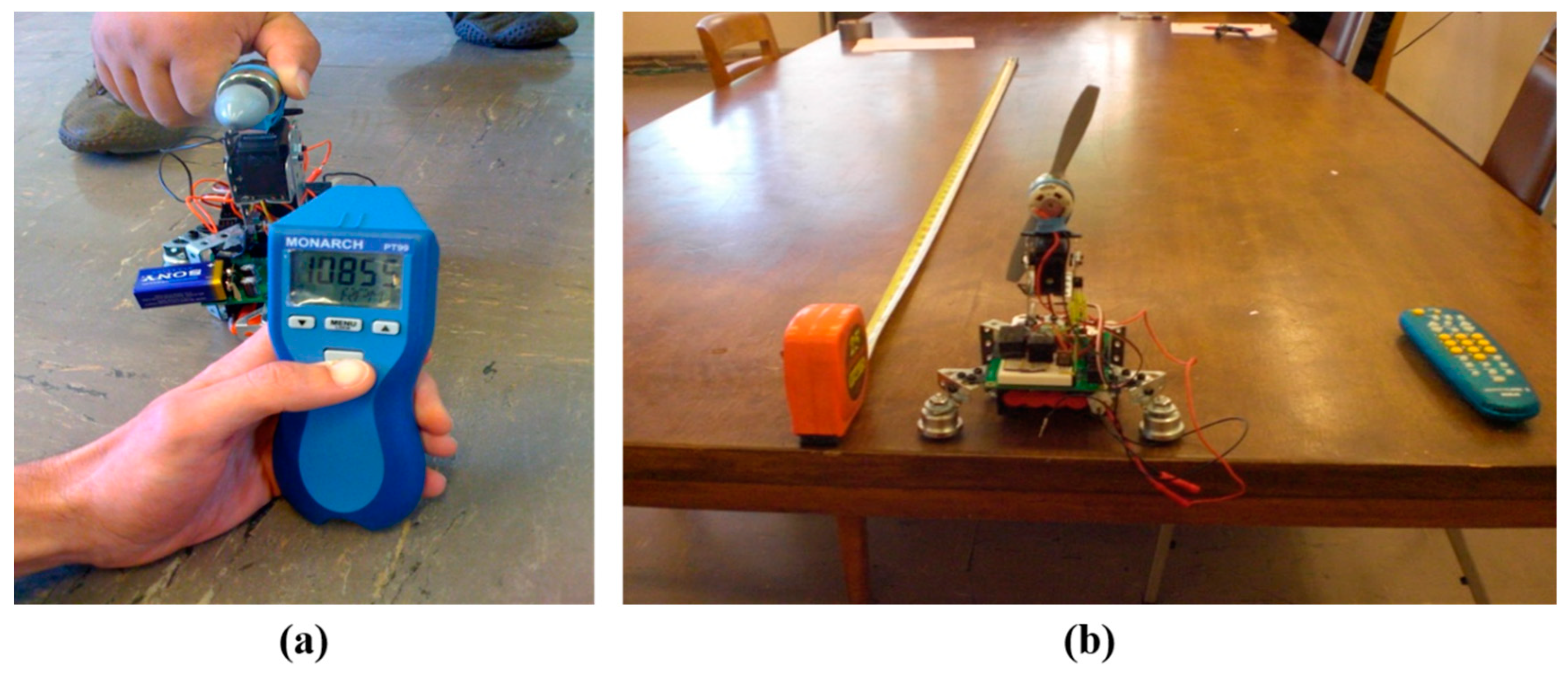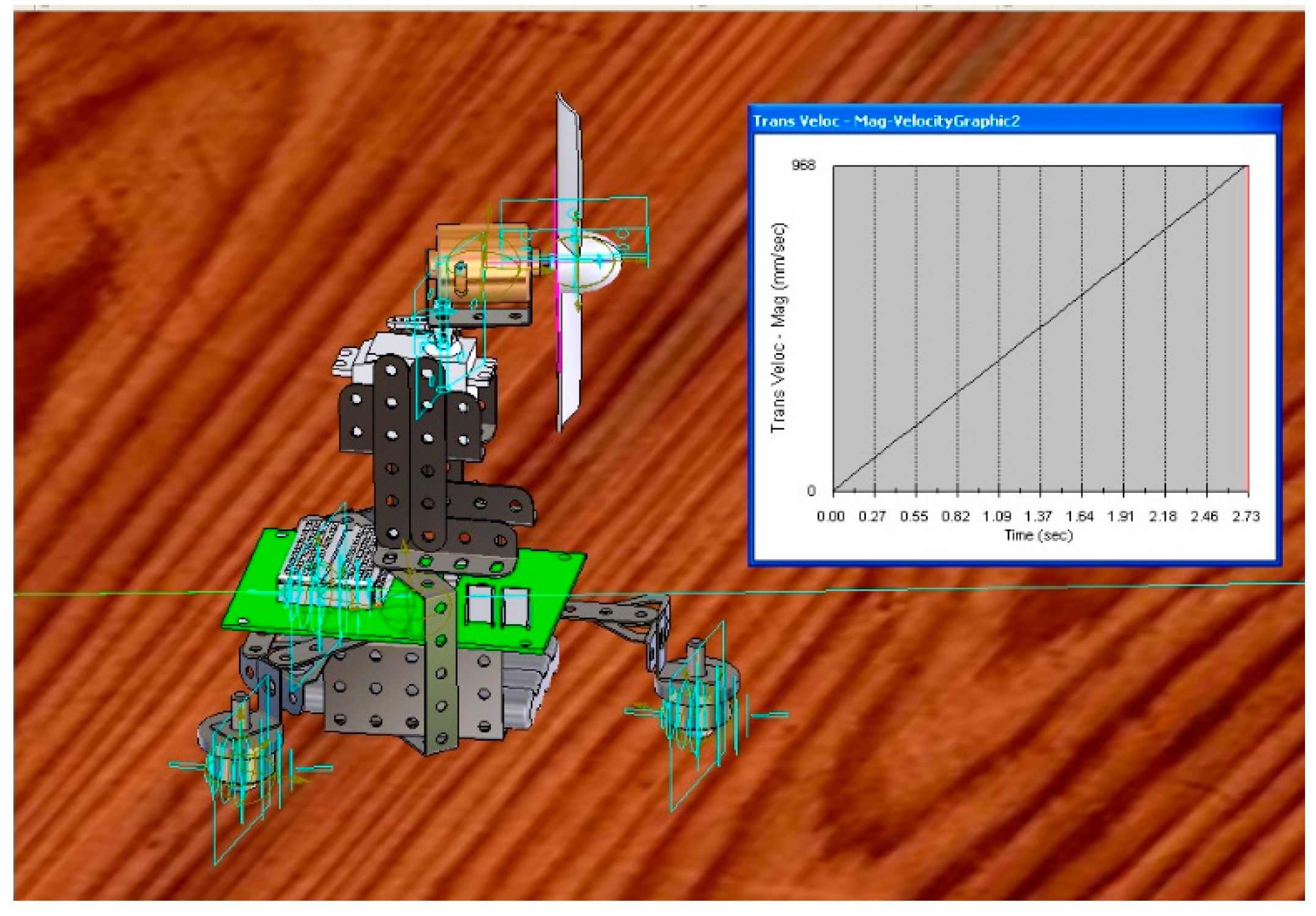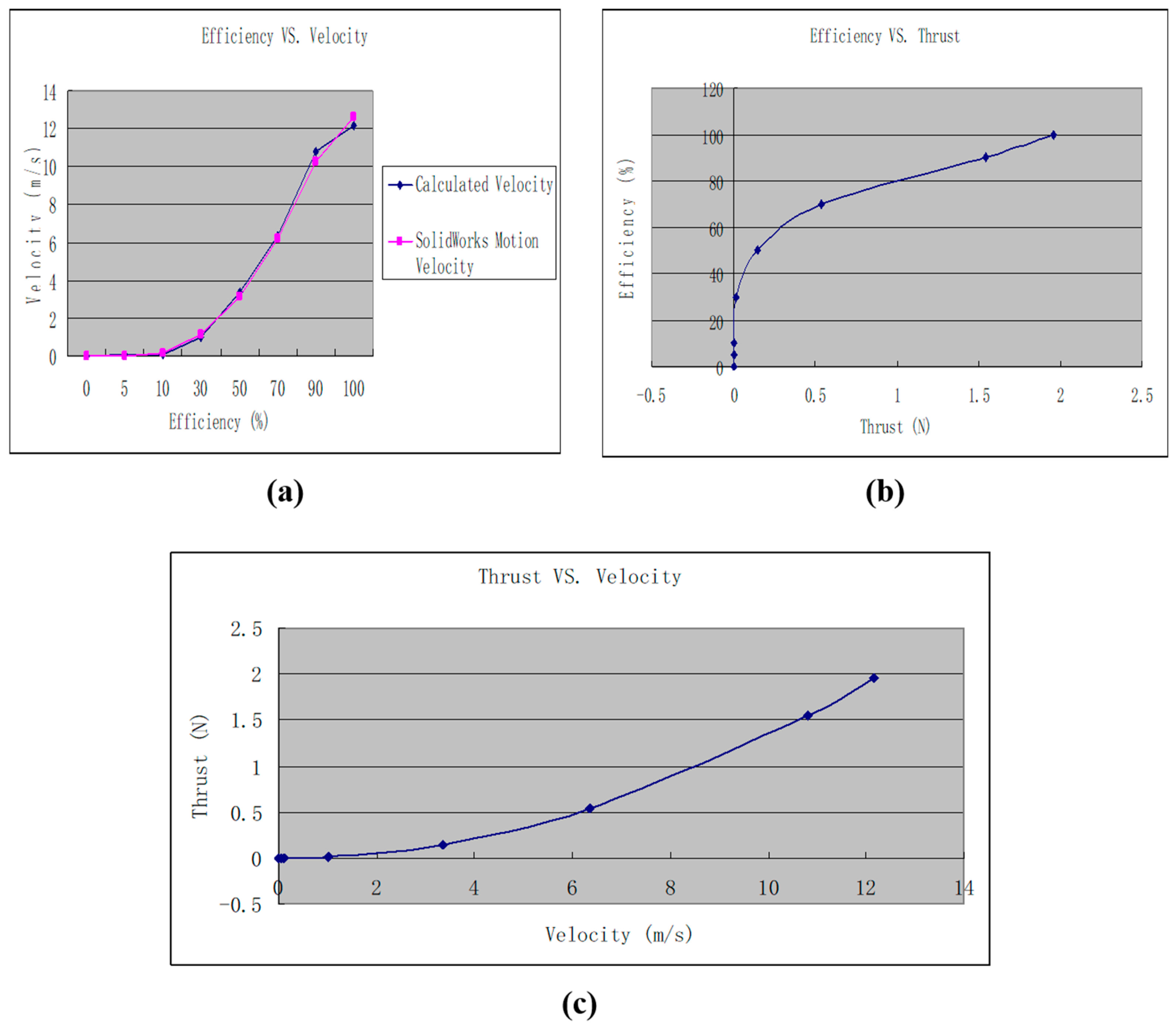Application of a Propeller-Based Air Propulsion System to the Land-Based Holonomic Vehicle
Abstract
:1. Introduction
2. Materials and Methods
2.1. Specification Requirements
- Omnidirectional driving: Realization of propulsion in any direction without the rotation of the vehicle body with ball-based wheels. This function can be fulfilled by increasing the motor number, but it will make the system complicated. So a breakthrough in the driving method is necessary.
- Simplicity: Simple structure and components comparable to nonholonomic systems are important for practical use. Casual control of the movement path without any path planning. In other words, the realization of omnidirectional mobility and effective control do not act upon the premise of an increased motor number and structural complication.
2.2. Concept and Experimental Design
2.3. Components
2.4. Equations and Analytical Methods
2.4.1. Power Required and Power Available
2.4.2. Relationship among Thrust Force, Velocity and the Propulsion Power
2.4.3. Efficiency of the Prototype
3. Results
4. Discussion
5. Conclusions
Author Contributions
Funding
Conflicts of Interest
Abbreviations
| Resistive force of friction | |
| Coefficient of friction | |
| Applied normal load | |
| Power | |
| Potential difference | |
| Current | |
| Displacement | |
| Initial velocity | |
| Time interval | |
| Diameter of propeller | |
| Velocity of incoming flow | |
| The density of the media | |
| Thrust | |
| η | Propeller efficiency |
| Additional velocity | |
| Pa | Available Power |
| Motor Power |
References
- Holmberg, R.; Khatib, O. Development and Control of a Holonomic Mobile Robot for Mobile Manipulation Tasks. Int. J. Robot. Res. 2000, 19, 1066–1074. [Google Scholar] [CrossRef]
- Holmberg, R.; Khatib, O. Development of a Holonomic Mobile RObot for Mobile Manipulation Tasks. In Proceedings of the International Conference on Field and Service Robotics, Pittsburgh, PA, USA, 29–31 August 1999; pp. 1–6. [Google Scholar]
- Asada, H.H.; Wada, M. The Superchair: A Holonomic Omnidirectional Wheelchair with a Variable Footprint Mechanism. Total Home Autom. Health/Elder. Care Consort. 1998, 31, 1–34. [Google Scholar]
- Tahboub, K.A.; Asada, H.H. Dynamics analysis and control of a holonomic vehicle with a continuously variable transmission. In Proceedings of the 2000 IEEE International Conference on Robotics and Automation, San Francisco, CA, USA, 24–28 April 2000; Volume 2463, pp. 2466–2472. [Google Scholar]
- Borenstein, J.; Evans, J. The OmniMate mobile robot-design, implementation, and experimental results. In Proceedings of the International Conference on Robotics and Automation, Albuquerque, NM, USA, 25 April 1997; Volume 3504, pp. 3505–3510. [Google Scholar]
- Fielding, M.R.; Dunlop, G.R. Omnidirectional Hexapod Walking and Efficient Gaits Using Restrictedness. Int. J. Robot. Res. 2004, 23, 1105–1110. [Google Scholar] [CrossRef]
- Mohd Salih, J.E.; Juhari Mohamed Rizon, M.; Yaacob, S.; Adom, A.; Rozailan Mamat, M. Designing Omni-Directional Mobile Robot with Mecanum Wheel. Am. J. Appl. Sci. 2006, 3, 5. [Google Scholar] [CrossRef]
- Diegel, O.; Badve, A.; Bright, G.; Potgieter, J.; Tlale, S. Improved Mecanum Wheel Design for Omni-directional Robots. In Proceedings of the 2002 Australasian Conference on Robotics and Automation, Auckland, New Zealand, 27–29 November 2002. [Google Scholar]
- Rojas, R.; Forster, A.G. Holonomic control of a robot with an omnidirectional drive. KI-Kunstl. Intell. 2006, 20, 7. [Google Scholar]
- Balkcom, D.A.; Kavathekar, P.; Mason, M. Time-optimal Trajectories for an Omnidirectional Vehicle. Int. J. Robot. Res. 2006, 25, 985–999. [Google Scholar] [CrossRef]
- Koshiyama, A.; Yamafuji, K. Design and Control of an All-Direction Steering Type Mobile Robot. Int. J. Robot. Res. 1993, 12, 411–419. [Google Scholar] [CrossRef]
- Tatsuro, E.; Nakamura, Y. An omnidirectional vehicle on a basketball. In Proceedings of the ICAR ’05. Proceedings, 12th International Conference on Advanced Robotics, Seattle, WA, USA, 18–20 July 2005; pp. 573–578. [Google Scholar]
- Rojas, R. Omnidirectional Control; Freie Universit¨at Berlin: Berlin, Germany, 2005. [Google Scholar]
- Valdmanis, M. Localization and Navigation of a Holonomic Indoor Airship Using On-board Sensors; McGill University: Montreal, QC, Canada, 2010. [Google Scholar]
- Roque, P.; Ventura, R. Space CoBot: Modular design of an holonomic aerial robot for indoor microgravity environments. In Proceedings of the 2016 IEEE/RSJ International Conference on Intelligent Robots and Systems (IROS), Daejeon, Korea, 9–14 October 2016; pp. 4383–4390. [Google Scholar]
- Ehlers, K.; Meyer, B.; Maehle, E. Full Holonomic Control of the Omni-directional AUV SMART-E. In Proceedings of the ISR/Robotik 2014; 41st International Symposium on Robotics, Munich, Germany, 2–3 June 2014. [Google Scholar]
- Tahboub, K.A.; Asada, H.H. Dynamics Analysis and Control of a Holonomic Vehicle With a Continuously Variable Transmission. J. Dyn. Syst. Meas. Control 2000, 124, 118–126. [Google Scholar] [CrossRef]
- Bonsen, B.; Pulles, R.J.; Simons, S.W.H.; Steinbuch, M.; Veenhuizen, P.A. Implementation of a slip controlled CVT in a production vehicle. In Proceedings of the 2005 IEEE Conference on Control Applications, 2005, Toronto, ON, Canada, 28–31 August 2005; pp. 1212–1217. [Google Scholar]
- Srivastava, N.; Haque, I. A review on belt and chain continuously variable transmissions (CVT): Dynamics and control. Mech. Mach. Theory 2009, 44, 19–41. [Google Scholar] [CrossRef]
- Rockwood, D.; Parks, N.; Garmire, D. A continuously variable transmission for efficient urban transportation. Sustain. Mater. Technol. 2014, 1, 36–41. [Google Scholar] [CrossRef]
- Moreno, J.; Clotet, E.; Lupiañez, R.; Tresanchez, M.; Martínez, D.; Pallejà, T.; Casanovas, J.; Palacín, J. Design, Implementation and Validation of the Three-Wheel Holonomic Motion System of the Assistant Personal Robot (APR). Sensors 2016, 16, 1658. [Google Scholar] [CrossRef] [PubMed]
- Runge, G.; Borchert, G.; Raatz, A. Design of a holonomic ball drive for mobile robots. In Proceedings of the 2014 IEEE/ASME 10th International Conference on Mechatronic and Embedded Systems and Applications (MESA), Senigallia, Italy, 10–12 September 2014; pp. 1–6. [Google Scholar]
- Wada, M.; Mori, S. Holonomic and omnidirectional vehicle with conventional tires. In Proceedings of the IEEE International Conference on Robotics and Automation, Minneapolis, MN, USA, 22–28 April 1996; Volume 3674, pp. 3671–3676. [Google Scholar]
- Mohanraj, A.P.; Elango, A.; Reddy, M.C. Front and Back Movement Analysis of a Triangle-Structured Three-Wheeled Omnidirectional Mobile Robot by Varying the Angles between Two Selected Wheels. Sci. World J. 2016, 2016, 7612945. [Google Scholar] [CrossRef] [PubMed]
- West, M.; Asada, H. Design and control of ball wheel omnidirectional vehicles. In Proceedings of the 1995 IEEE International Conference on Robotics and Automation, Nagoya, Japan, 21–27 May 1995; Volume 1932, pp. 1931–1938. [Google Scholar]
- Rasam, H.R. Review on Land-Based Wheeled Robots. In Proceedings of the MATEC Web of Conferences, Saint-Petersburg, Russia, 15 April 2016; Volume 53, p. 01058. [Google Scholar]
- Merchant, M.P.; Miller, L.S. Propeller Performance Measurement for Low Reynolds Number Unmanned Aerial Vehicle Applications. In Proceedings of the 44th AIAA Aerospace Sciences Meeting and Exhibit, Reno, NV, USA, 9–12 January 2006; pp. 1–13. [Google Scholar]
- Lorussi, F.; Marigo, A.; Bicchi, A. Optimal exploratory paths for a mobile rover. In Proceedings of the 2001 ICRA. IEEE International Conference on Robotics and Automation (Cat. No.01CH37164), Seoul, Korea, 21–26 May 2001; Volume 2072, pp. 2078–2083. [Google Scholar]
- Dimitrov, D.; Yoshida, K. Utilization of Holonomic Distribution Control for Reactionless Path Planning. In Proceedings of the 2006 IEEE/RSJ International Conference on Intelligent Robots and Systems, Beijing, China, 9–15 October 2006; pp. 3387–3392. [Google Scholar]
- Conradt, J. Laboratory Notes Helping Neuromorphic Sensors Leave the Designer’s Desk. Neuromorphic Eng. 2005, 2, 8–9. [Google Scholar]
- Anggraeni, D.; Sumaryanto, A.R.; Sumarna, E.; Rahmadi, A. Engine and propeller selection for propulsion system LAPAN Surveillance UAV-05 (LSU-05) using analytic and experimental test. In Proceedings of the International Seminar of Aerospace Science and Technology II, Tangerang, Jakarta, Indonesia, 11 November 2014; pp. 41–50. [Google Scholar]
- Anggraeni, D.; Hidayat, D.; Pramutadi, A.M.; Rasyadi, A. Design and Flight Test of a Medium Range UAV for Aerial Photography. Int. J. Unmanned Syst. Eng. 2015, 3, 40–49. [Google Scholar] [CrossRef]
- Takahashi, K.; Fujimoto, H.; Hori, Y.; Kobayashi, H.; Nishizawa, A. Modeling of propeller electric airplane and thrust control using advantage of electric motor. In Proceedings of the 2014 IEEE 13th International Workshop on Advanced Motion Control (AMC), Yokohama, Japan, 14–16 March 2014; pp. 482–487. [Google Scholar]
- Power, T. Flight Thrust, Power, and Energy Relations. MIT education: 2009. pp. 1–4. Available online: http://web.mit.edu/16.unified/www/SPRING/systems/Lab_Notes/airpower.pdf (accessed on 18 August 2019).
- Čerkala, J.; Jadlovska, A. Mobile Robot Dynamics with Friction in Simulink. In Proceedings of the 22th Annual Conference Proceedings of the International Scientific Conference—Technical Computing Bratislava 2014, Bratislava, Slovakia, November 2014; pp. 1–10. [Google Scholar]
- Martin, H. How a Propeller Works. Available online: https://www.mh-aerotools.de/airfoils/ (accessed on 5 May 2019).
- Muir, P.F.; Neuman, C.P. Kinematic modeling of wheeled mobile robots. J. Robot. Syst. 1987, 4, 281–340. [Google Scholar] [CrossRef]
- Cawood, G. Summary of Omni-Directional Drive Choices. Available online: https://pdfs.semanticscholar.org/639c/11466c9377435653d137993f4c7b88b8e237.pdf (accessed on 18 August 2019).
- Chen, X.; Chen, Y.Q.; Chase, J. Mobiles Robots—Past Present and Future. IntechOpen: 2009. Available online: https://www.intechopen.com/books/mobile-robots-state-of-the-art-in-land-sea-air-and-collaborative-missions/mobiles-robots-past-present-and-future (accessed on 18 August 2019).
- Brezina, A.; Thomas, S. Measurement of Static and Dynamic Performance Characteristics of Electric Propulsion Systems. In Proceedings of the 51st AIAA Aerospace Sciences Meeting including the New Horizons Forum and Aerospace Exposition, Grapevine, TX, USA, 7–10 January 2013; pp. 1–30. [Google Scholar]
- Bouabdallah, S.; Siegwart, R.; Caprari, G. Design and Control of an Indoor Coaxial Helicopter. In Proceedings of the 2006 IEEE/RSJ International Conference on Intelligent Robots and Systems, Beijing, China, 9–15 October 2006; pp. 2930–2935. [Google Scholar]
- Bouabdallah, S.; Murrieri, P.; Siegwart, R. Design and control of an indoor micro quadrotor. In Proceedings of the IEEE International Conference on Robotics and Automation, 2004, New Orleans, LA, USA, 26 April–1 May 2004; Volume 4395, pp. 4393–4398. [Google Scholar]
- Khosiawan, Y.; Nielsen, I. A system of UAV application in indoor environment. Prod. Manuf. Res. 2016, 4, 2–22. [Google Scholar] [CrossRef] [Green Version]




| Measurements | Symbol | Data | Units |
|---|---|---|---|
| Propeller RPM | RPM | 8000–13,000 | RPM |
| Diameter of Propeller | D | 0.166 | m |
| Weight of Prototype | m | 0.808 | kg |
| Coefficient of Static Friction | μ | 0.2–0.6 | / |
| Coefficient of Rolling Friction | CTT | 0.0012 | / |
| Displacement | Δx | 1.524 | m |
| Average Time | Δt | 2.73 | sec |
| Power of Motor | Pengine | 1.44 | W |
| Category | Calculated Results | Units |
|---|---|---|
| Friction Force (Static) | 1.582–4.474 | N |
| Friction Force (Rolling) | 0.00949 | N |
| Actual Velocity | 0.558 | m/s |
| Acceleration | 0.409 | m/s2 |
| Actual Efficiency | 18.55 | % |
| Trial | Time (sec) |
|---|---|
| 1 | 2.49 |
| 2 | 2.81 |
| 3 | 2.72 |
| 4 | 2.93 |
| 5 | 2.71 |
| Average | 2.73 |
| Efficiency (%) | Thrust (N) | Velocity (m/s) | SolidWorks Motion (m/s) | Error Percentage (%) |
|---|---|---|---|---|
| 0 | 0 | 0 | 0 | 0 |
| 5 | 0.000002719 | 0.0453 | 0.032 | 41.6 |
| 10 | 0.000163244 | 0.111 | 0.126 | 11.9 |
| 30 | 0.013622846 | 1.014 | 1.136 | 10.7 |
| 50 | 0.148246405 | 3.345 | 3.151 | 6.16 |
| 70 | 0.536264756 | 6.362 | 6.194 | 16.8 |
| 90 | 1.54482245 | 10.798 | 10.235 | 5.5 |
| 100 | 1.96201222 | 12.169 | 12.613 | 3.5 |
© 2019 by the authors. Licensee MDPI, Basel, Switzerland. This article is an open access article distributed under the terms and conditions of the Creative Commons Attribution (CC BY) license (http://creativecommons.org/licenses/by/4.0/).
Share and Cite
Zhang, S.; Huang, W. Application of a Propeller-Based Air Propulsion System to the Land-Based Holonomic Vehicle. Appl. Sci. 2019, 9, 4657. https://doi.org/10.3390/app9214657
Zhang S, Huang W. Application of a Propeller-Based Air Propulsion System to the Land-Based Holonomic Vehicle. Applied Sciences. 2019; 9(21):4657. https://doi.org/10.3390/app9214657
Chicago/Turabian StyleZhang, Sheng, and Wenjing Huang. 2019. "Application of a Propeller-Based Air Propulsion System to the Land-Based Holonomic Vehicle" Applied Sciences 9, no. 21: 4657. https://doi.org/10.3390/app9214657





